
* The rapid development of American Mach 2 combat aircraft in the 1950s inevitably led to the development of a Mach 2 strategic bomber, the "B-58 Hustler". As it turned out, a Mach 2 bomber was not a particularly practical idea; the B-58 was produced only in small numbers and did not remain in service for very long. Early on, however, there were plans to follow the B-58 with a much more capable supersonic bomber, the "B-70 Valkyrie", but only two XB-70 prototypes were built. This document describes the rise and fall of the B-58 and XB-70. A list of illustrations credits is included at the end.
* The Convair company of Fort Worth, Texas, USA, began conceptual studies on a supersonic bomber in October 1946, with the investigation designated "Generalized Bomber (GEBO)". GEBO led to a second, more practical study designated "GEBO-II", begun in March 1949, when the Cold War was beginning in earnest.
That was two years after Boeing had test-flown the first modern jet bomber, the B-47 Stratojet, and three years before Boeing would test-fly the B-47's bigger and badder successor, the B-52 Stratofortress. At the time, there were no supersonic combat aircraft in operational service, and first-line bombers of the US Air Force (USAF), such as the Convair B-36, were primarily piston-powered. However, aeronautical engineering was advancing by leaps and bounds at the time, and it paid to be forward-looking.
Convair engineers focused on the delta wing for the supersonic bomber. The concept of the delta wing had been invented by Dr. Alexander Lippisch of Germany in the 1930s, though the Germans never got a powered delta-wing aircraft into the air during the war. Convair researchers had been working on the same idea late in the war, and in 1948 Convair tested the delta wing on the XF-92 experimental aircraft. The XF-92 would lead along another path to the Convair F-102 Delta Dagger and its follow-on, the superlative F-106 Delta Dart.
A delta-winged aircraft has a number of disadvantages: early delta-wing aircraft couldn't use flaps, since they just pushed the nose back down, and so they had a long take-off run; the low wing loading of a delta makes for a rough ride at low altitude; and it loses speed quickly on turns, limiting maneuverability. However, it is a simple, robust configuration that offers high straight-line speed and plenty of volume for fuel tanks. Many first-generation Mach-2 combat jets were delta-winged.
Convair engineers initially focused on "parasite bomber" schemes, involving a relatively small supersonic bomber that would be carried by a B-36 to the target area. The USAF's Strategic Air Command (SAC), which owned the service's nuclear strike role, wasn't impressed by the parasite scheme. Fortunately, Convair was also working on a more conventional bomber concept, and after a test program involving wind tunnel models, rocket-boosted models, and radio-controlled air-dropped models, in October 1952 the USAF requested that Convair develop a full-scale supersonic bomber prototype.
The Convair supersonic bomber was to be powered by the General Electric (GE) X24A afterburning turbojet engine, then in development. The X24A would emerge as the GE J79, which would be the powerplant for several famous American supersonic aircraft, including the Lockheed F-104 Starfighter and the McDonnell Douglas F-4 Phantom II. Initial prototypes of the supersonic bomber were to be powered by the Pratt & Whitney J57 turbojet until the J79 became available.
Convair assigned the supersonic bomber project the designation "MX-1964". Boeing was working on a competing swept-wing supersonic bomber project with the designation of "Model 484" or "MX-1965". In mid-1952, the Air Force gave the Convair bomber the service designation of "XB-58" and the Boeing bomber the service designation of "XB-59". In October 1952, the Air Force selected the Convair XB-58 for further development. This led to award of a contract in February 1953, specifying delivery of two prototypes of the Convair aircraft, including one "XB-58" bomber prototype and one "XRB-58" reconnaissance aircraft prototype. They were also known by the USAF "weapon system" designations of "WS-102A" and "WS-102L" respectively, and jointly by the company designation of "Convair Model 4".
* While the XB-58 was clearly seen at the outset as a delta-winged aircraft with four J79 engines and stores in a pod carried under the belly, little else was certain, and a wide range of different configurations was considered -- some with engines podded together, some with engines above and below the wing, and so on.
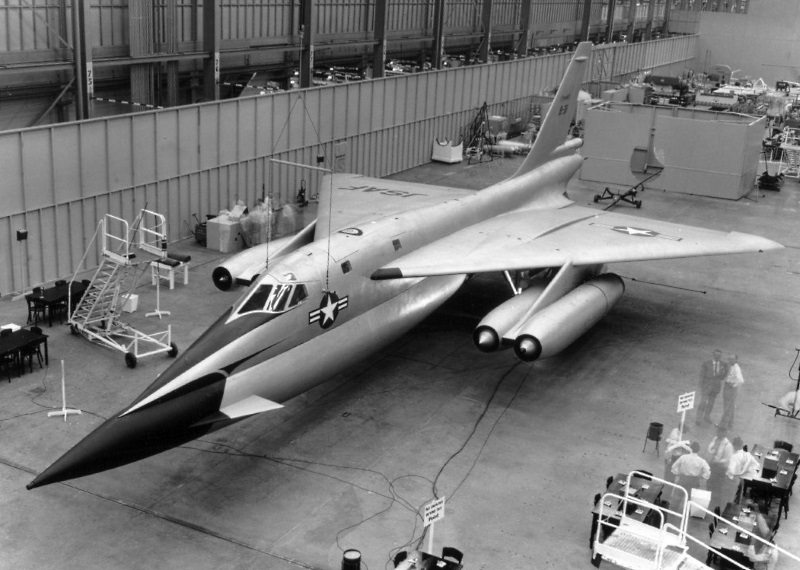
One important design feature was soon added in the form of "area ruling", a concept devised by engineer Richard Whitcomb of the US National Advisory Committee for Aviation (NACA), the primary predecessor organization of the modern US National Aeronautics & Space Administration (NASA). Whitcomb's area ruling was based on the concept that an aircraft would have better supersonic performance if there were as little change as possible in its cross-sectional area along its length, ensuring that airflow didn't encounter abrupt transitions in its path along the aircraft. That meant that as the wing span increased, the fuselage diameter shrank, resulting in a "wasp-waist" or "Coke bottle" configuration that not only improved performance, but usually improved an aircraft's appearance as well.
However, the XB-58 design did not really begin to converge to a solution until the spring of 1953, after Convair had been bought out by General Dynamics (GD). The final design had a delta wing with a leading-edge sweep of 60 degrees and a trailing-edge sweep of 10 degrees, with slightly downturned wingtips. The four engines were fitted in individual nacelles slung under the wings, and a new GE T-171 (later M61) Vulcan six-barreled 20-millimeter Gatling-type cannon was fitted in the tail for defense.
A single high-yield nuclear weapon was to be carried in a long belly pod. A reconnaissance pod could be fitted as an alternate payload. The pod also carried equipment and fuel. The pod was used because attempting to cram the payload into the fuselage of the aircraft inflicted too much of a performance penalty.
* Unfortunately, when GD told Air Force brass in June 1954 that the XB-58's first flight had to be pushed back from January 1956 to June 1956, the service balked. That didn't seem like much of a schedule slip, but the XB-58 program had already cost $300 million USD, and there were doubts among USAF brass that a Mach 2 bomber really made any sense. Even the SAC commander, General Curtis LeMay, stated in a January 1955 memo that SAC neither wanted nor needed the B-58, since the B-58's range was only half that of the B-52.
There were more general issues as well: subsonic bombers could do the conventional bombing job much more cheaply, and the future of strategic nuclear strike clearly seemed to belong with intercontinental ballistic missiles (ICBM), then in development by both the USA and the USSR. LeMay's logic was hard to argue with and, in fact, would grow even harder to argue with in the future -- though many other senior Air Force generals would be reluctant to accept the message.
B-58 advocates still won out in the short run, with the Air Force ordering 11 "YB-58" trials machines in December 1955. The first XB-58 prototype took to the air on 11 November 1956, with the secret aircraft announced to the public at the same time. The aircraft was fitted with GE J79-GE-1 engines, with 39.58 kN (4,035 kgp / 8,900 lbf) maximum dry thrust and 64.5 kN (6,575 kgp / 14,500 lbf) afterburning thrust. As it turned out, the J79 was available in time and no B-58 was ever fitted with P&W J57s. The second prototype, which was completed simply as an "XB-58" and not as an "XRB-58", first flew in February 1957.
First service delivery of the "Hustler" -- the name was invented by the Convair engineering crew, and the Air Force liked it -- was in February 1959; on 15 October 1959, this machine flew at Mach 2 for over an hour, achieving true "supersonic cruise". In the interim, 17 more trials aircraft had been ordered, for a total of 30.
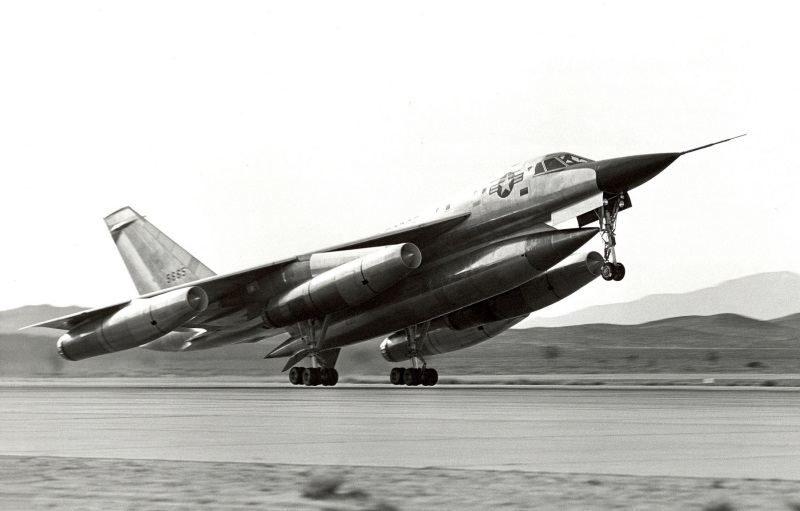
Given the advanced nature of the aircraft, the trials proved troublesome, with five of the first 20 machines lost in accidents; the causes of some of the losses were never determined. Well-known test pilot Joe Cotton later commented: "I felt then, and still feel now, that the airplane flew before it should have ... I always wondered if the Hustler had first flown in 1958, we would probably have a few more fine people alive today. But I guess they could not wait when we were fighting a Cold War."
BACK_TO_TOP* The B-58 was a spectacular aircraft in almost every regard, elegant with its long, slender, wasp-waisted fuselage and its clean delta wing, sporting four J79 engines, with the inner pair on long swept-forward pylons and the outer pair on short stub pylons. All but the first seven B-58s were fitted with J79-GE-5A or -5B turbojets, with 43.16 kN (4,400 kgp / 9,700 lbf) maximum dry thrust and 69.4 kN (7,075 kgp / 15,600 lbf) afterburning thrust. Most earlier B-58s were retrofitted with these engines.
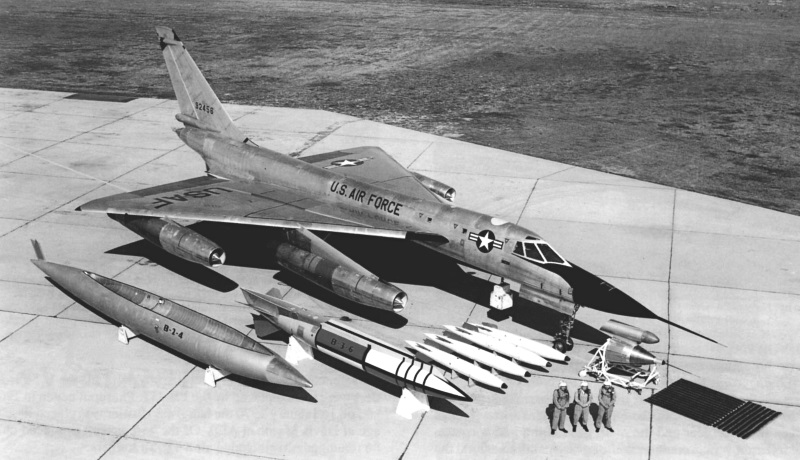
The B-58 had long, spindly-looking but strong, tricycle landing gear to allow ground clearance for the engines and the weapons pod. Flight controls were driven by redundant hydraulic systems.
___________________________________________________________________
GENERAL DYNAMICS B-58 HUSTLER:
___________________________________________________________________
wingspan:
17.3 meters (56 feet 10 inches)
wing area:
143.25 sq_meters (1,542 sq_feet)
length:
29.5 meters (96 feet 9 inches)
height:
9.6 meters (31 feet 5 inches)
empty weight:
25,200 kilograms (55,560 pounds)
max loaded weight:
80,200 kilograms (176,890 pounds)
maximum speed:
2,205 KPH (1,370 MPH / 1,190 KT)
cruise ceiling:
19,500 meters (64,000 feet)
range (typical):
6,600 kilometers (4,100 MI / 3,565 NMI)
___________________________________________________________________
The B-58 gave an impression of being a very big fighter jet. This was emphasized by the seating arrangement, which was much more like that of a fighter than a bomber. There were three crew members, including pilot, bombardier-navigator, and defensive systems operator (DSO), with each sitting in his own individual enclosure in tandem, accessed by separate clamshell doors on top of the fuselage. There was no room to move around, except for a crawlway between the second and third seats. The crew was essentially strapped into their seats as they would be in a fighter; a "clothesline" system was fitted along the cabin wall to allow them to pass notes or small items back and forth. The pilot had a good view through a six-piece windscreen, with his seat offset so he didn't have to stare through the center post, but the two back-seaters had to make do with small windows on either side of the cockpit.
Early production featured conventional rocket-boosted ejection seats, but in 1962, after the deaths of aircrew in high-speed ejections, a new "escape capsule" was developed that sealed each crewman into a clamshell capsule to improve his chances of survival in a supersonic ejection. The capsule would self-stabilize after ejection; had inflatable flotation devices for water landings; and featured a survival kit, including a radio, a survival rifle, and even a change of clothing. The escape capsule was retrofitted to older B-58s.
Incidentally, the escape capsule was tested using live bears as subjects. A sow bear named "Yogi" -- after "Yogi Bear", a popular cartoon character of the era, a play on the name of baseball great Yogi Berra -- who weighed about as much as a typical pilot was, sedated, packed into the capsule, and then ejected at 10,700 meters and 1,400 KPH (870 MPH / 755 KT) on 21 March 1962. She suffered no ill effects. Two weeks later, a boar bear named "Big John" went through much the same routine, and also came through just fine. It seems the bears were intelligent and very tame, being treated like "big pets" by the researchers, though pets that no doubt the researchers were not inclined to provoke. Unfortunately, the heavy sedation required for their participation in tests threw off their biometric readings, and so bears never became regular test subjects for ejection seats.
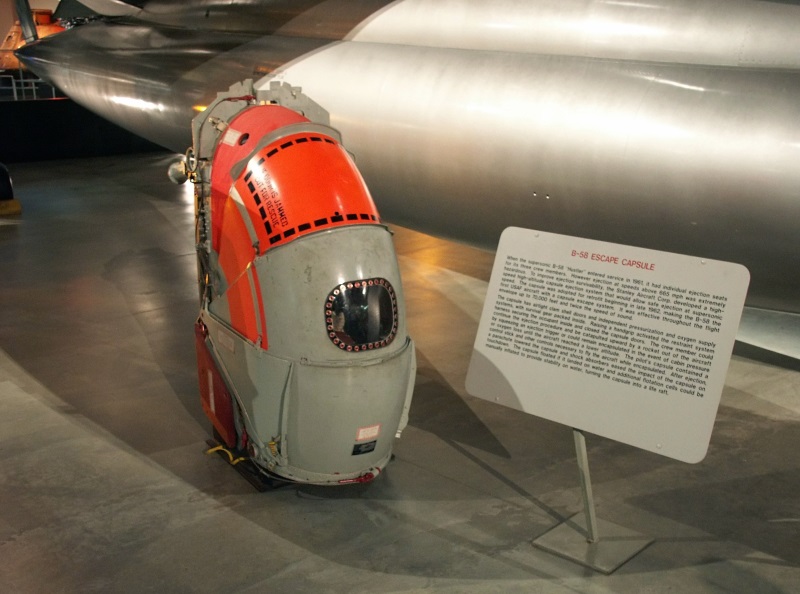
Anyway, not all aircrews were enthusiastic about the escape capsule, preferring the earlier, simpler ejection seats. Their reasoning was that it was very unlikely that anyone would survive an abrupt catastrophe at Mach 2, and in less immediate emergencies the aircraft would be subsonic very rapidly. One B-58 was lost when the windscreen was shattered by hail and the pilot's capsule went shut; although he had some limited ability to control the aircraft from inside the capsule, that didn't include throttle settings, and he couldn't open up the capsule before he ejected even though the B-58 had passed out of the hailstorm. The crew punched out, with the navigator being killed when his parachute didn't open. After that, a cable was added to allow the capsule to be re-opened from the inside.
The B-58's construction was as innovative as its appearance. Much of the aircraft was made of sandwich panel composed of fiberglass sheet faced by thin aluminum on each side, a scheme that proved both strong and heat-resistant, as required for Mach 2 flight. In areas where the fiberglass sandwich wasn't strong enough, a similar sandwich with thin aluminum sheet filler was substituted. In areas exposed to unusual levels of heat, as was the case in areas under the wing near the engine exhausts, a sandwich material based on stainless steel was used. The panels were held in place by titanium screws.
The end result was an aircraft with a remarkably low empty weight. There was literally a price to pay, however, since fabricating the honeycomb sheets to the desired tolerances was a difficult and expensive process, and fitting the panels in place on the aircraft during manufacture was equally troublesome. Expensive high-precision jigs were required. Worse, replacing a panel in the field meant placing the entire aircraft in such a high-precision jig. That made maintenance difficult, to say the least, particularly in comparison to other aircraft in the USAF inventory.
The aircraft's GE J79 engines were another marvel. They had an inlet spike that automatically adjusted for airflow and reduced the chances of high-speed engine stall. In afterburner, the engines could easily move the Hustler to its redline speed of Mach 2.2. They could provide even more thrust in an emergency, but the airframe itself simply wasn't strong enough to fly any faster.
The B-58 had a large fuel capacity, with a "wet" wing divided into fore and aft tanks. Total wing fuel capacity was 34,100 liters (9,000 US gallons). The skin panels were fitted with gasketing to allow them to serve as the tank walls. In addition, there were two tanks in the rear fuselage, helping provide a total fuselage fuel capacity of 19,000 liters (5,000 US gallons). The weapons pods could also accommodate fuel, and in fact the fuel capacity of the aircraft was so great that it didn't have enough runway to take off when fully loaded. It got into the air with an incomplete fuel load and then "topped off" from a tanker once airborne.
The rearmost fuselage tank was mostly intended as a ballast tank to maintain pitch trim as fuel was expended. Fuel trim proved to be a major problem during initial aircraft flight tests, and so the production aircraft's fuel system was correspondingly elaborate. The B-58 was fitted for boom-type inflight refueling, with a refueling socket in the nose forward of the cockpit.
A considerable amount of engineering effort was expended on the Hustler's landing gear, which perched the aircraft about 2.75 meters (9 feet) off the ground with the weapons pod removed. The steerable nose gear had twin wheels and a vertical travel of about 38 centimeters (15 inches). Each of the main gear had a total of eight wheels, with four mounted on two axles, with a vertical travel of about 43 centimeters (17 inches). All three gear assemblies retracted backward.
The main gear tires were relatively small, only 56 centimeters (22 inches) in diameter, to allow them to fit inside the thin wings, which still had to be fitted with shallow fairings to accommodate the gear. The tires were filled with nitrogen to a pressure of about 19 atmospheres / bars (280 pounds per square inch), about eight times the pressure of an automobile tire. The aircraft's tires had to bear up under tremendous loads at high rolling speeds and often blew out. Extended taxiing was ruled out, and sharp turns had to be avoided. After a hot landing, the tires were often cooled by a blower system hauled out on the runway by the ground crew. In fact, on touchdown the Hustler's tires tended to tear up bits of the runway, until the Air Force coated the runways with a mixture of sand and epoxy to make the surface more durable. Delta-wing aircraft tend to land fast, and so the B-58 had a ribbon-style drag parachute to reduce the landing roll.
The B-58 featured a state-of-the-art avionics suite. A Raytheon targeting radar was fitted in the nose, and the pilot was assisted by an autopilot that provided a "watchdog" capability, preventing the pilot from taking maneuvers that would be dangerous in supersonic flight. The bombardier-navigator, in the second seat, used a Sperry-Rand AN/ASQ-42V electronic navigation system, featuring a KS-39 astro-tracker and an AN/APN-113 Doppler navigation radar. The AN/ASQ-42V was highly capable and accurate, though since it was built with 1950s technology, it weighed about 550 kilograms (1,200 pounds). Today, a system with better capabilities could be built in less than a tenth that size.
The DSO sat in the third seat. He controlled a powerful electronic countermeasures (ECM) system to blind enemy radars, including an AN/ALQ-16 active jammer and an AN/ALE-16 chaff dispenser. If an enemy fighter still managed to get on the Hustler's tail -- an unlikely event, since the aircraft moved very fast at altitudes above the ceilings of most contemporary fighters -- the DSO could direct the Vulcan cannon in the tail "stinger" via a radarscope to engage the fighter. Incidentally, the Hustler also featured a warning system to provide voice alerts, using comments recorded in a female voice on the notion that the male crew would pay more attention to it; the voice system was called "Sexy Sally".
The standard "MB-1C" weapons pod carried by the B-58 was a big spindle with tailfins. It was 17.4 meters (57 feet) long, 1.5 meters (5 feet) in diameter, and had a fully loaded weight of 16,325 kilograms (36,000 pounds). It carried both a W39Y1-1 multi-megaton nuclear weapon and fuel, with the fuel stored in tanks at both ends to ensure trim. The pod was mounted slightly off center from the aircraft's centerline so that it would spin-stabilize after drop. When the B-58 was parked on the runway without the pod, a counterweight had to be attached to the aircraft to keep it from tipping back on its tail. The B-58A was originally to have carried an "MA-1C" liquid-fuel stand-off missile with a range of 260 kilometers (160 miles) instead of a weapons pod; however, the guidance systems available at the time were not accurate enough to make the MA-1C practical.
After the introduction of the B-58, the Air Force began to have doubts about the utility of a bomber that could only carry a single nuclear weapon, and so between 1961 and 1963 all B-58s were retrofitted with four stub pylons, arranged in tandem under the wing roots, to carry Mk 43 or Mk 61 nuclear weapons.
A photo-reconnaissance pod, designated the "LA-331", was fielded. It was a modification of the MB-1C pod, carrying a Fairchild KA-56 panoramic camera instead of a nuclear bomb. The camera was fitted in the pod's nose, along with a scanner system that pivoted the camera to provide unblurred images at high speed and low level.
More specialized pods were considered, but not fielded. An "MD-1" ECM pod was built, but apparently not flown; a radar reconnaissance pod fitted with a huge Hughes AN/APQ-69 side looking airborne radar (SLAR) was test-flown in 1959, leading to tests of the more compact AN/APS-73 SLAR in the early 1960s. A Hustler carrying the AN/APS-73 SLAR was sent over Cuba during the Missile Crisis in October 1963. That was apparently the only time a Hustler ever overflew hostile airspace.
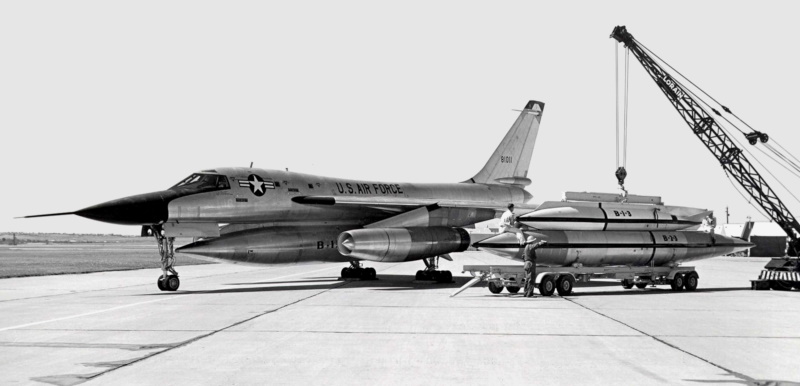
Problems with fuel leaks led to the development of a new "two-component pod (TCP)" system that used twin stacked pods, with the upper pod carrying a BA53-Y1 nuclear weapon along with barometric sensors, and the lower pod amounting to a big drop tank that would be discarded during an operational mission once exhausted. Oddly, few pictures of the stacked pod system are available. Whether this was because it wasn't used very much, or because it was simply unphotogenic, is difficult to say.
BACK_TO_TOP* After production of the first 30 trials aircraft, 86 production B-58s were built, for a total of 116 Hustlers in all. Production ended in the fall of 1962. Most of the trials aircraft were brought up to operational specification, though eight other trials aircraft were modified into "TB-58A" trainers, see below. The primary B-58 users were the SAC 43rd Bomb Wing at Carswell, Texas, and later Little Rock, Arkansas, and the 305th Bomb Wing at Bunker Hill, Indiana, later renamed Grissom Air Force Base.
The Hustler's performance was astounding. It was capable of flying as fast or faster than any fighter it might encounter, and generally at higher altitudes than a fighter could reach. One Convair engineer stated: "That thin wing and the delta sweep made going through the sound barrier like slicing a piece of cheese. It would penetrate the sound barrier without any shaking or anything."
The B-58 had a blazing rate of climb, often described as "like a rocket", particularly when the aircraft was lightly loaded. The B-58 was also surprisingly maneuverable for an aircraft of its size, and although delta wings are supposed to give a bumpy flight at low altitude, the Hustler was perfectly adept at low-level penetration flights.
The B-58 set a number of records, including a low-level flight covering 1,930 kilometers (1,200 miles / 1,044 NMI) at altitudes of under 150 meters (500 feet) with an average speed of 1,100 KPH (683 MPH / 610 KT), and a dash climb to a maximum altitude of 26,025 meters (85,360 feet). One Hustler flew from Los Angeles to New York and back in four hours, 41 minutes.
In October 1963, another B-58 appropriately named GREASED LIGHTNING flew from Tokyo to London. Despite the fact that it had to slow down for five aerial refuelings, its average speed over the 14,850-kilometer (9,232-mile / 8,028-NMI) flight was 1,726 KPH (1,073 MPH / 933 KT). Cruise speed for five hours of the journey was 2,276 KPH (1,414 MPH / 1,230 KT) at an altitude of 16,160 meters (53,000 feet); the aircraft would have had an even higher average speed if it hadn't lost an afterburner late in the mission.
The Hustler was a very demanding aircraft. Only very experienced flight crews were assigned to it, and some aircrew were frightened of it. That was not because it was badly engineered, it was just because it was pushing the envelope of aircraft design and it could be dangerously unforgiving. Ignoring the prescribed ranges of angle of attack in take-off, landing, and cruise could be fatal. Maintaining fuel trim was tricky, particularly when fuel gauges and valves failed. Loss of an engine at high speed could cause the aircraft to yaw drastically and rip itself to pieces. Loss of hydraulic control demanded an immediate bailout. Despite the fact that it was intimidating, there was no shortage of aircrew lined up to fly it, since it was so incredibly sexy; some pilots said they loved the thing, it seems not so much in spite of the fact they were terrified every instant it was in motion, but because of it.
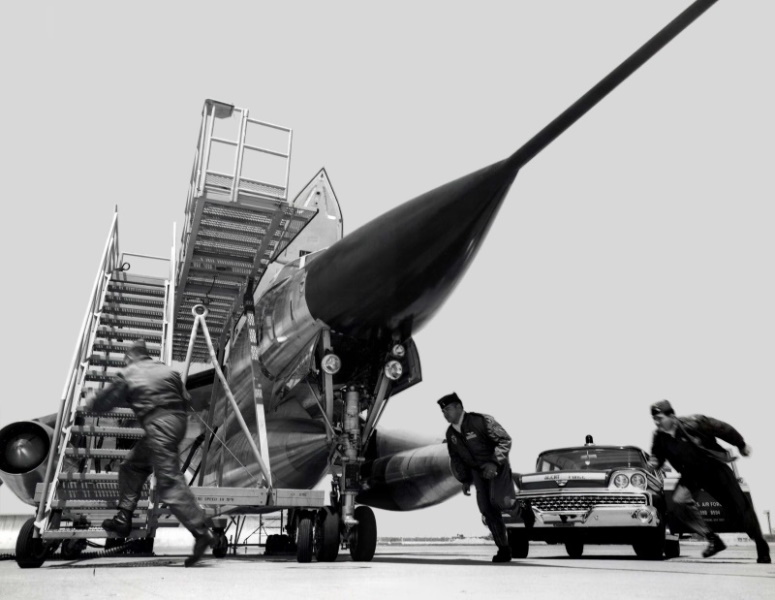
26 of the 116 B-58s built were lost in accidents, with 36 aircrew killed, and the type had the unfortunate distinction of suffering fatal crashes twice at the Paris Air Show, once in 1961 and again in 1965. The TB-58A rebuilds were performed to help deal with the difficulties in flying the type, and the accident rate dropped dramatically after their introduction.
* By the late 1960s, the argument over the manned supersonic bomber that had gone back and forth since the Hustler's development had tipped decisively against it. The B-58 was an amazing aircraft, but it was just too expensive to operate. To the extent that SAC still believed in the manned bomber, the subsonic Boeing B-52 could do the job. For the cost of operating two B-58 wings, SAC could operate six B-52 wings. Some SAC brass also disliked the B-58 because of its high accident rate.
The B-58 never fired a shot in anger. Although the war in Southeast Asia was in full blaze by the mid-1960s, the Hustler was simply not cost-effective for conventional bombing, though in 1967 the Air Force did experiment with several B-58s for conventional strike in Project BULLSEYE. The four stores pylons were modified for the carriage of conventional bombs, and the aircraft were flown on low-level strike test missions out of Eglin AFB in Florida. Some rumors have it that B-58s were painted in jungle camouflage in place of the normal natural metal finish for these tests, but there is little evidence that this is true.
The last B-58 was removed from operational service in early 1970. The type's operational career only spanned a decade, a modest interval for a modern military aircraft. Seven survive on static display and one derelict is apparently being rebuilt, but it seems very unlikely the Hustler will ever fly again.
BACK_TO_TOP* A number of B-58 variants were considered, though in practice only one version of the B-58 was built, along with some minor variations and experimental fits.
Trials aircraft were designated "YB-58". Production aircraft were designated "B-58A", or usually just "B-58" since there never was a B-58B. Trainers were designated "TB-58" or "TB-58A", and were intended to give new B-58 pilots familiarization in flying a demanding aircraft. That couldn't be done very well in a standard B-58 since there was no copilot seat, meaning a pilot new to the type was on his own on his very first flight. The second seat position was modified to accommodate a flight instructor, and distinctive additional rear windshield panel extensions plus a "skylight" were added to give the instructor a better view. Most combat systems were removed.
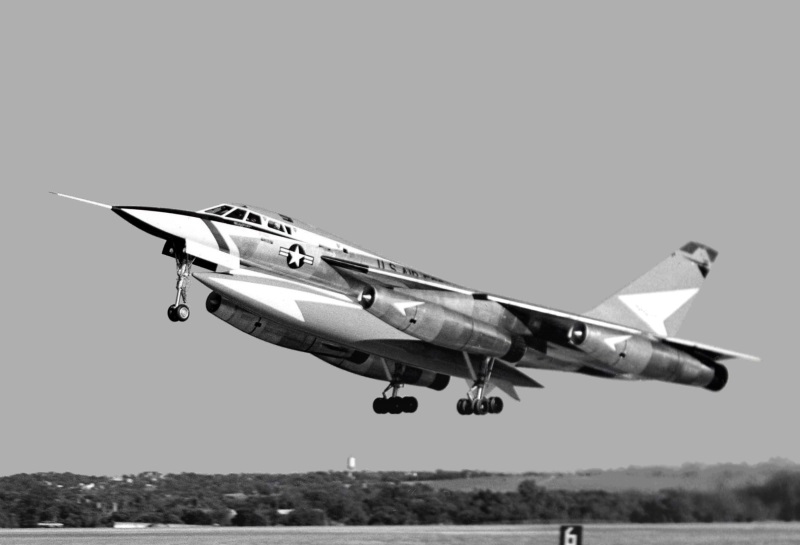
Hustlers fitted with the LA-331 reconnaissance pod were designated "RB-58" or "RB-58A". It seems that RB-58As also carried some specialized equipment to control the pod and support the reconnaissance mission.
B-58s were used in limited numbers as test aircraft. One particularly impressive test configuration involved the fit of the huge YJ93 engine for the North American XB-70 bomber to the third B-58 built, replacing the aircraft's weapons pod. This aircraft was designated the "NB-58A". Another B-58 was used to test the AIM-47 missile weapons system for the Lockheed YF-12A, an unproduced interceptor version of the SR-71 Blackbird reconnaissance aircraft. This B-58 was fitted with an extended nose to accommodate the AN/ASG-18 radar for the interceptor and was affectionately known as "Snoopy", after the long-nosed beagle in the popular contemporary PEANUTS comic strip. The missiles were fired from a modified weapons pod, with such tests conducted from May 1962 to February 1964.
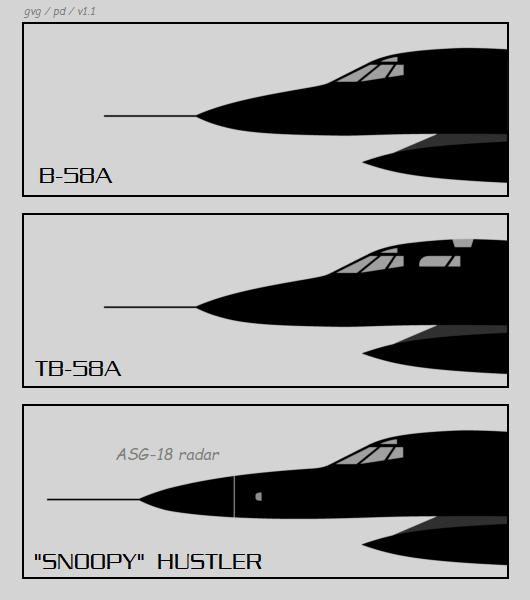
GD proposed a "B-58B" in 1958, featuring uprated J79-GE-9 engines; a fuselage stretch; canards; and a conventional weapons capability. A B-58A was slated for conversion to a B-58B prototype, but the program was canceled. A "B-58C" was also proposed, involving a larger aircraft powered by two or four Pratt & Whitney J58 engines, used on the SR-71 Blackbird, with 144.6 kN (14,740 kgp / 32,500 lbf) thrust each. The B-58C would have had Mach 3 performance, but the Air Force didn't buy the idea.
Proposals were considered for using the B-58 as a strategic missile launcher, and Lockheed built a 9.15-meter (30-foot) long solid fuel "air launched ballistic missile (ALBM)" derived from the company's X-17 test booster. The ALBM was test-launched four times in 1958 and 1959, with two successful trials. In the fourth and last launch, on 22 September 1959, the ALBM was supposed to be launched into space to take a picture of an American Explorer satellite under Project SNAP SHOT. This was a proof-of-concept test with applications for satellite inspection and anti-satellite interception, but that particular launch failed. The B-58 ALBM program was then abandoned, though the B-52-based "Skybolt" ALBM program persisted for a few more years.
A screwball scheme was proposed in which the Hustler would launch a high-speed ramjet-powered expendable aircraft, the "Super-Hustler", to penetrate enemy airspace at speeds of up to Mach 4. The expendable aircraft would be piloted, but most of the aircraft would be discarded before the piloted section returned to base. Nothing came of this idea directly, though the basic concept would be revived with the unsuccessful Lockheed D-21 unmanned ramjet reconnaissance drone of the 1970s.
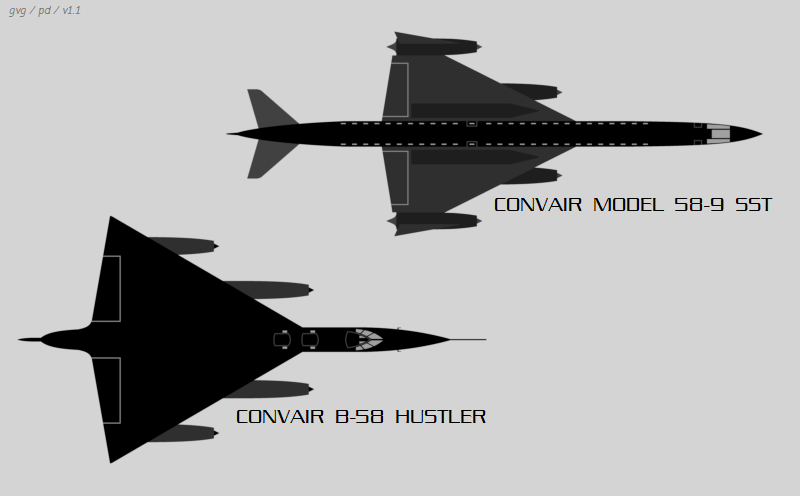
There were even schemes for building a supersonic transport based on the Hustler. One military transport concept involved a Hustler fitted with a modified pod with accommodations for five passengers, to be used when getting important personnel to a location was critical and cost wasn't a problem. Somewhat more practically, GD also considered a commercial Hustler transport derivative, with the fuselage stretched by about 50% to provide seating for 52 passengers. This concept was designated the "Model 58-9". Nothing came of these ideas, either; supersonic transports were never a very practical idea.
BACK_TO_TOP* Even before the first flight of the B-58, the Air Force was considering a "bigger and better" follow-on, issuing a request in 1954 that formally emerged in 1955 as "Weapons System 110 (WS-110)", which specified a high-altitude bomber that would carry a heavy warload and cruise at Mach 3 over long range at high altitude.
Boeing and North American submitted proposals, but the concepts weren't exactly what the Air Force wanted. These aircraft would have had a loaded weight of over 450 tonnes (a million pounds); were too big to fit into existing B-52 hangars and other facilities; and could only achieve Mach 3 for a short dash over the target. The proposals were rejected. Both companies went back to the drawing board, and found that they could in fact build a bomber with a warload of 18.2 tonnes (20,000 pounds) that could cruise at Mach 3 at an altitude of over 21 kilometers (70,000 feet), and would be able to use existing facilities.
North American won the competition in December 1957. The company's design, designated "B-70", was of canard configuration, featuring a long, sleek fuselage with small canard wings mounted near the cockpit, and a large delta wing in the rear that was fitted with twin tailfins. The bomber was to be powered by six General Electric J93 turbojets, each with an afterburning thrust of over 127.5 kN (13,000 kgp / 30,000 lbf). The engines, bomb bay, and landing gear were all contained in a single wedge-shaped unit under the center of the delta wing. The tricycle landing gear featured twin-wheel nose gear and four-wheel main gear assemblies. The aircraft was to be constructed mostly of lightweight stainless-steel honeycomb, with titanium used in specific heat-critical sections.
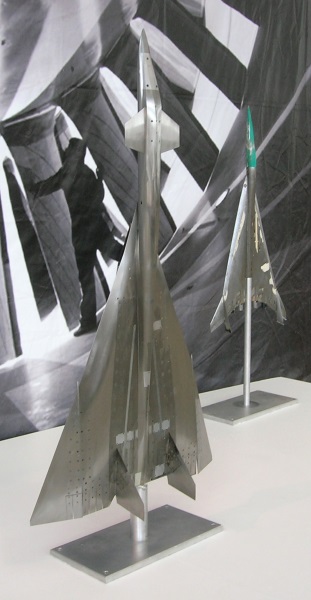
The B-70 also incorporated an unusual feature: the outboard 6 meters (20 feet) of the wings could fold down. This scheme was derived from research that showed that trapping the shockwave generated by a supersonic aircraft could generate very high lift. The B-70 would take off with the wingtips straight; at subsonic cruise speed, they would be lowered to 25 degrees, and above about Mach 1.4, to 65 degrees. The folding wingtips not only improved lift, they also allowed smaller tailfins to be used, and compensated for the delta wing's backwards shift in its center of lift as speed increased.
* However, as the B-70 design solidified, as noted earlier second thoughts about supersonic high-altitude bombers began to emerge. With the new ICBMs like Atlas, Titan, and Minuteman coming into service or being developed, what could the B-70 do that ICBMs couldn't do better? President Dwight Eisenhower was pointedly skeptical. The Air Force was then obtaining a powerful fleet of B-52 bombers at great expense to the taxpayer; to the extent there was a still a need for a manned bomber -- and the B-52's subsequent operational history would prove there was -- were Air Force brass saying that it couldn't do the job, that all that money was for nothing? Eisenhower was very annoyed at the persistent efforts of the generals to lobby for the B-70 in Congress, calling it "damn near treason".
In December 1959 the B-70 program was cut back to a single prototype. Program backers managed to restore funding to a level adequate for as many as a dozen of the bombers; incoming President John F. Kennedy was no more enthusiastic about the B-70 than Eisenhower had been, and on 1 March 1961, Kennedy announced that the program was to be scaled back once more. Three aircraft would be completed, including two "XB-70" flight test prototypes and one "YB-70" operational prototype.
The two XB-70s were to be pure flight research aircraft. Most of the combat-related avionics, such as the bombing-navigation system, were deleted, and the bombardier and navigator positions were deleted as well, leaving provisions only for pilot and copilot. NASA would collaborate with the USAF on the flight tests. The YB-70 was to have full combat systems. The idea was that the machine would be useful as a hedge against changing conditions to retain the option of putting the B-70 into production after all. However, the expense and the continuously dwindling logic of fielding the B-70 meant that only the two prototypes were built. Formally speaking, it appears that the XB-70 was actually the "XB-70A", but as there never was an "XB-70B", the "XB-70" usage is retained here.
BACK_TO_TOP* The first XB-70 was rolled out at North American's Palmdale, California, facility on 11 May 1964. By this time the type had been named the "Valkyrie", and the initial prototype was designated "Air Vehicle 1 (AV/1)", with tail number 20001. AV/1 performed its first flight on 21 September 1964. After a number of teething problems, AV/1 punched through Mach 1 for the first time on 12 October 1964.
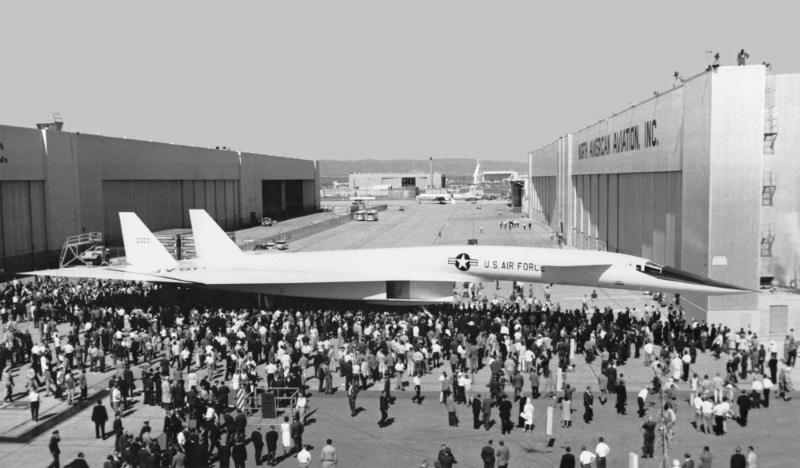
Flight tests of AV/1 continued into 1965, with the aircraft demonstrating sustained supersonic flight at speeds of Mach 1.4 to above Mach 2. On its 12th flight, on 7 May 1965, while cruising at Mach 2.58, a piece of the wing broke away and shut down four of the engines. The aircraft managed to make it back to the runway, but all six engines had to be replaced.
___________________________________________________________________
NORTH AMERICAN XB-70 VALKYRIE:
___________________________________________________________________
wingspan:
32 meters (105 feet)
wing area:
586.2 sq_meters (6,298 sq_feet)
length (no test boom):
56.7 meters (185 feet 10 inches)
height:
9.38 meters (30 feet 9 inches)
empty weight:
136,055 kilograms (300,000 pounds)
max take-off weight:
246,365 kilograms (542,000 pounds)
maximum speed:
3,310 KPH (2,056 MPH / 1,787 KT)
service ceiling:
23,580 meters (77,350 feet)
ferry range:
6,925 kilometers (4,300 MI / 3,740 NMI)
___________________________________________________________________
* By the summer of 1965, AV/2, with tail number 20207, had been rolled out and was ready to fly. AV/2 took to the air on 17 July 1965, and began its own series of supersonic flight tests. Tests continued with both XB-70s. On 14 October 1965, AV/1 made a short dash through Mach 3 at 21 kilometers altitude, but lost a small chunk of her outer wing. AV/1 was never flown faster than Mach 2.5 again. There were similar concerns that AV/2 might not be robust enough for Mach 3 flight, either. Flight tests were planned so that the aircraft would be run at Mach 2.8 or Mach 2.9 for an extended time to thermally condition the aircraft for dashes above Mach 3.
Mach 3 flight imposes a severe thermal burden on an aircraft. Heat buildup rises drastically with increases in speed at high Mach, and is far more a limiting factor to high-speed flight than engine power. The XB-70 was an extremely "clean" aircraft, which minimized heat buildup, but the nose and other leading parts of the aircraft did rise to 330 degrees Celsius (625 degrees Fahrenheit), while the rest of the aircraft remained at 232 degrees Celsius (450 degrees Fahrenheit).
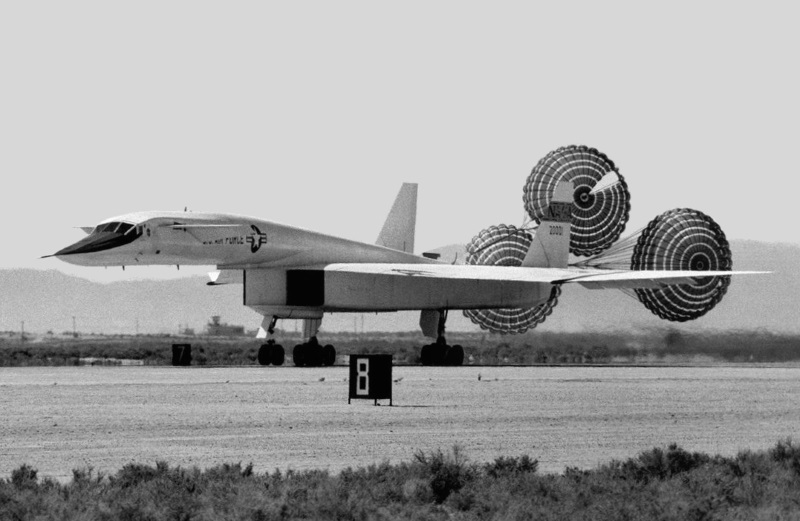
Airframe cooling was provided by an ingenious, if somewhat hair-raising, arrangement of the fuel tanks that allowed the fuel to soak up the heat from the airframe. The hot fuel was bled off to the engines, conveniently preheated to improve engine performance. However, as the fuel was bled off, the space evacuated had to be replaced with inert nitrogen gas, since if any appreciable amount of oxygen leaked in, the fuel in the tanks would have exploded immediately.
In any case, tests continued, with AV/2 pushing the envelope up to and past the Mach 3 mark. It provided data relevant to the supersonic transport (SST) designs then being considered, in particular showing that the sonic booms caused by such an aircraft would be unacceptable over populated areas.
Since the two XB-70s were prototypes, and very big and complicated prototypes at that, the test flights often suffered from various system failures. On her 37th flight in March 1966, AV/1 almost came to grief when both hydraulic systems failed and the landing gear didn't deploy correctly. The aircraft managed to make a controlled landing at Edwards, though the landing roll was almost 4.8 kilometers (3 miles), and the aircraft went through a slow 110-degree turn on the ground.
AV/2 got into a similar jam on 30 April 1966, when various systems failed and the nose gear wouldn't go down. Trying two touch-and-go landings on the main gear to pop the nose gear down didn't work, and landing with the nose gear up would mean certain disaster. After flying in circles for a few hours, engineers suggested that the crew hotwire around a circuit breaker in a backup electrical system; the flight crew improvised a jumper with a paper clip, and the nose gear went down.
* Despite the glitches, progress was good. On 19 May 1966, AV/2 flew at Mach 3 for a sustained 33 minutes. By that time, Phase 1 flight tests were nearing completion. Phase 2 would follow, with NASA becoming increasingly involved in the test flights.
Then, on 8 June 1966, AV/2 participated in a photo shoot, flying with four other aircraft powered by General Electric engines so GE photographers could take promotional pictures. One of the aircraft was an F-104 Starfighter, flown by well-known test pilot Joe Walker. He was positioned off the XB-70's right wingtip when the photo shoot ended. When Walker broke formation the turbulence off the big aircraft's wingtips spun the Starfighter around, causing it to collide with the XB-70. The Starfighter tore off both of the XB-70's tailfins and part of its left wing, then exploded in a fireball. Walker was killed immediately.
AV/2 pilot Al White and copilot Carl Cross heard the impact, but everything seemed to be OK for the moment. Then the aircraft went into two slow rolls and broke into a spin. White managed to eject, but Cross went down with the aircraft as it slammed into the ground a few kilometers north of Barstow, California.
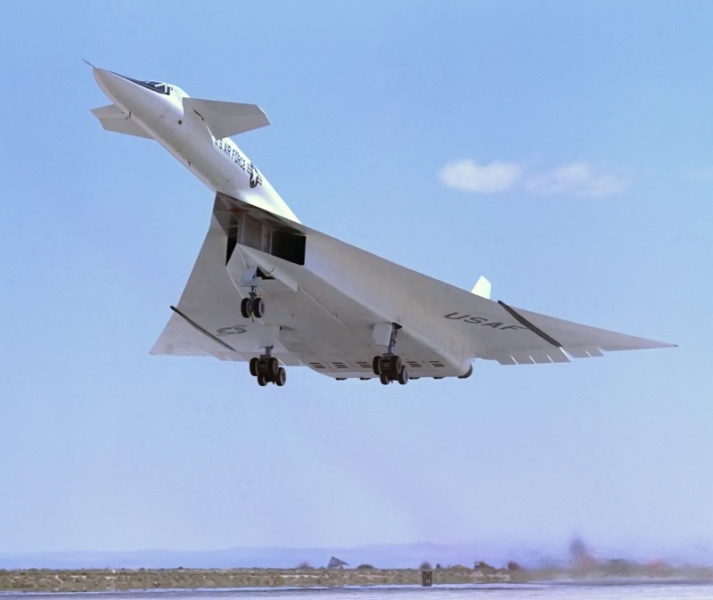
* Some modifications were made to the surviving AV/1 to eliminate a few of the problems discovered during her test flights, but since AV/1 was redlined to Mach 2.5, she was not a satisfactory replacement for supersonic tests, and the USAF dropped out of the test program after a few more flights. NASA conducted 33 more test flights until 4 February 1969, when AV/1 was flown to Wright Field near Dayton, Ohio and placed in the USAF Museum, where she resides today.
Neither the Air Force nor North American got out of the supersonic bomber business, with studies for a low-level fast bomber eventually leading to the modern B-1, designed by Rockwell, as North American had been renamed. The B-1 is an impressive piece of military hardware, but it is essentially optimized for high subsonic flight at very low level, and somehow just does not have the same whizziness as the XB-70.
BACK_TO_TOP* One of the interesting footnotes to the XB-70 program was that technology developed for the XB-70 was to also be applied to a huge long-range interceptor / escort fighter named the "F-108A". The F-108A had the distinction of being the last fighter project worked on by North American.
The Rapier project was initiated by the USAF in October 1955, originally under the designation of "Long Range Interceptor / Experimental (LRIX)", leading to the award of a contract to North American in June 1957 for two F-108A prototypes. The F-108A would have Mach 3 performance and range adequate to intercept Soviet bombers flying over the North Pole to attack North America, and was also considered as an escort for the B-70. The Air Force hoped to have the F-108A in service by 1963, and contemplated buying hundreds of them.
The F-108A was to be a two-seat aircraft, powered by twin J93 engines and armed with advanced Falcon missiles. It evolved through a number of configurations, converging on a design implemented in a mock-up unveiled in January 1959. The type received the name "Rapier" in May of that year.
As the F-108A was conceived at that time, it looked something like the fuselage of the North American "Vigilante" carrier-based bomber, then in flight test, mated to a high-mounted cranked delta wing with drooping wingtip panels, featuring a single tall tailfin on the end of the fuselage and a smaller inverted tailfin under the middle of each wing.
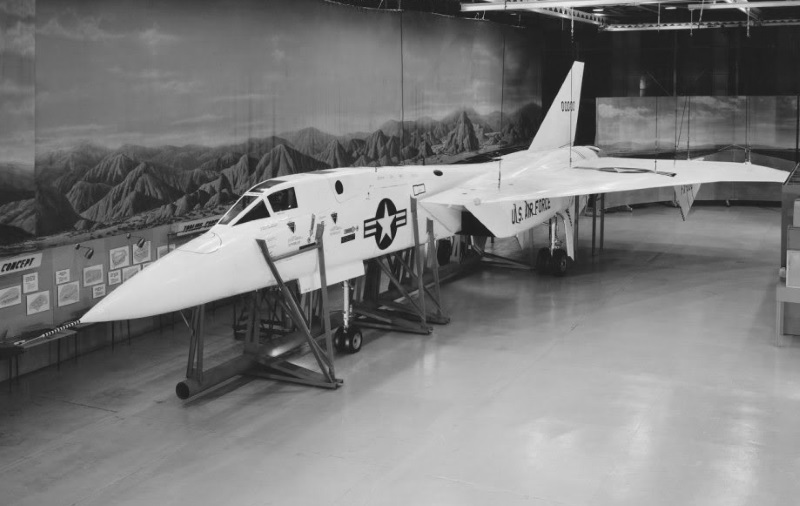
The crew were to sit in tandem seats fitted with ejection capsules for high-speed escape. The Rapier was to be armed with three GAR-9 advanced Falcon long-range air-to-air missiles, directed by the aircraft's powerful AN/ASG-18 radar -- as mentioned above, evaluated by the "Snoopy" Hustler.
___________________________________________________________________
NORTH AMERICAN F-108A RAPIER (ESTIMATED SPECIFICATIONS):
___________________________________________________________________
wingspan:
17.5 meters (57 feet 5 inches)
wing area:
173.4 sq_meters (1,865 sq_feet)
length:
27.2 meters (89 feet 2 inches)
height:
6.73 meters (22 feet 1 inch)
empty weight:
23,000 kilograms (51,000 pounds)
max loaded weight:
46,700 kilograms (103,000 pounds)
maximum speed:
3,200 KPH (2,000 MPH / 1,740 KT)
service ceiling:
23,000 meters (75,000 feet)
ferry range:
4,000 kilometers (2,500 MI / 2,175 NMI)
___________________________________________________________________
Initial flight of the first prototype was scheduled for the spring of 1961, but the USAF was already having second thoughts. The Soviet nuclear force was moving towards ICBMs, and an expensive dedicated long-range interceptor didn't seem like it was worth the money any more. The Rapier program was canceled in September 1959. The GAR-9 (later AIM-47A) missile and the AN/ASG-18 were later used with the Lockheed YF-12A, which never got out of the prototype stage.
BACK_TO_TOP* The B-58 and the XB-70 were certainly completely whizzy aircraft, far more advanced aerodynamically than the B-52 -- but at the beginning of the 21st century the B-52 was still flying operational missions, decades after both the B-58 and XB-70 had been grounded. The logic that argued against the supersonic high-altitude manned bomber was simply too hard to dispute. Strategic strike could be performed by missiles, while conventional strike could be performed by attack aircraft and, increasingly, cruise missiles. Whether the B-58 and the XB-70 were really a good use of taxpayer money is arguable, but that argument hardly diminishes the appeal of these two beautiful flying machines.
I have to mention that some Hustler fans have written data sheets on a Hustler variant with eight J79 engines, and even a twin-fuselage variant with ten engines. I suspect these sheets were released on 1 April of some year.
* Sources include:
I also picked up some details on the more exotic variants from Joe Baugher's exhaustive website on US military aircraft, which also provided information on the XB-70.
* Illustrations details:
* Revision history:
v1.0 / 01 nov 00 / Originally B-58 only. v1.1.0 / 01 nov 01 / Minor detail update. v1.1.1 / 01 nov 03 / Review & polish. v1.1.2 / 01 oct 05 / Review & polish. v1.1.3 / 01 mar 06 / Review & polish. v1.1.4 / 01 feb 08 / Review & polish. v1.1.5 / 01 jan 10 / Review & polish. v1.1.6 / 01 dec 11 / Review & polish. v2.0.0 / 01 sep 12 / Added XB-70. v2.0.1 / 01 aug 14 / Review & polish. v2.0.2 / 01 jul 16 / Review & polish. v2.0.3 / 01 jun 18 / Review & polish. v2.0.4 / 01 may 20 / Illustrations update. v2.0.5 / 01 aug 21 / Review & polish. v2.0.6 / 01 feb 22 / Review & polish. v2.0.7 / 01 jan 24 / Review & polish. (+)
The XB-70, as noted, was originally discussed in a stand-alone document, released in 1997 and running through seven revisions into 2010.
BACK_TO_TOP